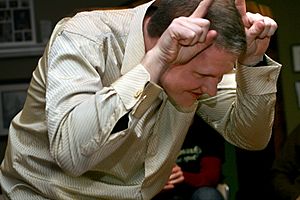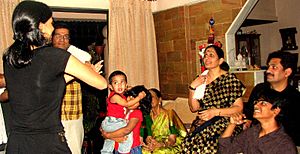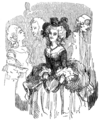Charades facts for kids
Charades is a parlor or party word guessing game. Originally, the game was a dramatic form of literary charades: a single person would act out each syllable of a word or phrase in order, followed by the whole phrase together, while the rest of the group guessed. A variant was to have teams who acted scenes out together while the others guessed. Today, it is common to require the actors to mime their hints without using any spoken words, which requires some conventional gestures. Puns and visual puns were and remain common.
The game has also been adapted into television shows like Acting Crazy, Party Game, Give Us a Clue, Body Language and Celebrity Charades.
Contents
Rules
As a long-lived and informal game, charades' rules can vary widely. Common features of the game include holding up a number of fingers to indicate the number of syllables in the answer, silently replying to questions, and making a "come on" gesture once the guesses become close; some forms of the games, however, forbid anything except physically acting out the answer. In a mixed setting, it is therefore advisable to clarify the rules before play begins.
Common features of the modern game include:
- Players divided into two or more exclusive teams.
- A notebook or scraps of paper, used for one team to write the answer(s) to be performed by a member of the other side. The answer(s) may be restricted to dictionary words, titles of artistic works, &c. to limit the difficulty. Words which cannot be explained other than by spelling (e.g., the or of) may be excluded from play except within larger phrases.
- A silent performance by the player to his or her teammates. To enforce a focus on physical acting out of the clues, silent mouthing of the words for lipreading, spelling, and pointing are generally banned. Humming, clapping, and other noises may be banned as well.
- A clock, timer, hourglass, &c. to limit the teams' guesses.
- A scoreboard or sheet to tally the teams' points: one for every correctly guessed answer and one for every answer the opposing team failed to guess within the allotted time.
- Alternation of teams until every player has acted at least once.
Common signals
Note that some of these signs may be banned from some forms of the game.
- A number of fingers at the beginning of play gives the number of syllables in the answer
- Pointing at or tugging on an earlobe means "sounds like"
- Moving hands or fingers closer together without touching means "shorter"
- Holding the hands or fingers close together without touching indicates a short word such as "the" or "of" that is difficult to act out on its own
- Moving hands or fingers farther apart means "more"
- "Come on", "close", or "keep guessing" may be indicated by any "come here" gesture or by holding one's hands toward each other and spinning them in circles
- "More" or "add a suffix" may be indicated by similar movements or by miming the act of stretching out a rubber band
- "I" may be signed either by gesturing to one's chest or eye
- "Yes, correct", in addition to more general signs such as nodding, is often expressed in charades by pointing at or touching the nose with one hand while pointing at the correct guesser with the other, signifying "on the nose"
Images for kids
-
The Triumph of Clytemnestra
-
Becky as a Louis-Quatorze Philomela
See also
 In Spanish: Charadas para niños
In Spanish: Charadas para niños






